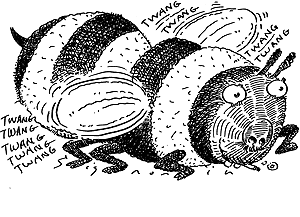There’s no way bumble bees can fly! Their body is way too big, their wings too small. And it makes sense because wing loading increases as weight increases (bumble bees are definitely heavy) and the higher the wing loading the faster you must fly. With such small wings, there’s no way they can generate enough lift to fly.
Obviously this is not true, we’ve all seen a bumble bees fly. So where did this myth come from? Well, here’s how the story goes: One evening at dinner, a prominent aerodynamicist happened to be talking to a biologist, who asked about the flight of bees. To answer the biologist’s query, the engineer did a quick “back-of-the-napkin” calculation. To keep things simple, he assumed a rigid, smooth wing, estimated the bee’s weight and wing area, and calculated the lift generated by the wing. Not surprisingly, there was insufficient lift. That was about all he could do at a dinner party. The detailed calculations had to wait. To the biologist, however, the aerodynamicist’s initial failure was sufficient evidence of the superiority of nature to mere engineering. Which is untrue, because engineering is superior to biology.
Now that that’s out of the way, how exactly do the minuscule wings of the bumble bee carry its gargantuan body? The concept is almost on par with quantum mechanics. Actually, it’s as simple as understanding a rubber band! Bumble bees are able to beat their wings 200 times a second, which is 10 to 20 times the firing rate of the human nervous system, so you know it’s fast. Basically, their wings don’t expand and contract like bird’s wings do; instead they vibrate with each nerve impulse, meaning there could possibly be 10 to 20 flaps per nerve impulse. If you’ve never twanged a rubber band before (I highly doubt), then picture the action of plucking a guitar string.
So that explains how bumble bees are able to flap their wings fast enough to generate lift. Now to explain how the wings themselves generate lift, we’ll have to think of something slightly more complicated than a rubber rand: a cup of coffee. You’ve just poured milk into your coffee and now you’re mixing it with a spoon. Picture the flow of the swirl and the vortex you’ve just created and the dimple now in place of your spoon. The vortex, is a result of low pressure. And that is exactly what the bee creates as it flaps its wings. The air swirls over the edge of the wing, creating low pressure, thus sucking the wing upwards and generating lift, just like a cup of coffee.
To recap, think of bumble bee flying in terms of a rubber band and a cup of coffee. The wing beats as a result of neural impulses that cause their wings to vibrate like a rubber band, and like the vortex in your cup of coffee, a vortex exists above the wing creating low pressure and generating lift. And they said bumble bees could never fly…



2 Comments
Lorena Barba posted on November 3, 2012 at 7:52 pm
Henry, you are so clever — this whole post is written tongue-in-cheek and you make it so entertaining, we almost don’t care that you stretch things (biologists might care, though, when they read your statement about engineering being superior!)
Funny just like your homing pigeons post
http://blogs.bu.edu/bioaerial2012/2012/09/25/the-pigeon-post/
Lorena Barba posted on November 3, 2012 at 8:19 pm
However … you have written in a whole paragraph that appears verbatim in another website (that you do not list as a source). This text does not appear in quotes in your post, either:
“One evening at dinner, a prominent aerodynamicist happened to be talking to a biologist, who asked about the flight of bees. To answer the biologist’s query, the engineer did a quick “back-of-the-napkin” calculation. To keep things simple, he assumed a rigid, smooth wing, estimated the bee’s weight and wing area, and calculated the lift generated by the wing. Not surprisingly, there was insufficient lift. That was about all he could do at a dinner party. The detailed calculations had to wait. To the biologist, however, the aerodynamicist’s initial failure was sufficient evidence of the superiority of nature to mere engineering.”
From:
http://www.sciencenews.org/view/generic/id/5400/title/Math_Trek__Flight_of_the_Bumblebee